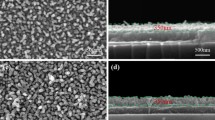Abstract
Hematite (α-Fe2O3) photoanodes are widely studied as candidates for water splitting photoelectrochemical (PEC) cells. To speed up the development of high efficiency hematite photoanodes, systematic investigations of the effect of material properties such as dopants and microstructure on PEC properties that determine the photoanode performance are crucial. Toward this end, this work presents a route for reproducible fabrication of thin film hematite photoanodes with reproducible microstructure and PEC properties. Hematite thin (50 nm) films are deposited by pulsed laser deposition from a Ti-doped (1 cation%) Fe2O3 target onto cleaned transparent conducting substrates (fluorinated tin oxide, FTO, coated glass substrates). Special attention is paid to rigorous cleaning of the substrates prior to the hematite deposition, which is found to be crucial for achieving highly reproducible results. Specimens prepared by this route display homogenous conformal coating with very little spread in PEC properties between different specimens, meeting the necessary prerequisite for systematic investigation of hematite photoanodes.










Similar content being viewed by others
References
N.S. Lewis and D.G. Nocera: Powering the planet: Chemical challenges in solar energy utilization. Proc. Natl. Acad. Sci. U. S. A. 103, 15729–15735 (2006).
J. Barber and P.D. Tran: From natural to artificial photosynthesis. J. R. Soc., Interface 10, 20120984 (2013).
M. Gratzel: Photoelectrochemical cells. Nature 414, 338–344 (2001).
M.G. Walter, E.L. Warren, J.R. McKone, S.W. Boettcher, Q. Mi, E.A. Santori, and N.S. Lewis: Solar water splitting cells. Chem. Rev. 110, 6446–6473 (2010).
G.A. Olah: Beyond oil and gas: The methanol economy. Angew. Chem., Int. Ed. 44, 2636–2639 (2005).
W. Wang, S. Wang, X. Ma, and J. Gong: Recent advances in catalytic hydrogenation of carbon dioxide. Chem. Soc. Rev. 40, 3703–3727 (2011).
K. Sivula, F. Le Formal, and M. Grätzel: Solar water splitting: Progress using hematite (α-Fe2O3) photoelectrodes. ChemSusChem 4, 432–449 (2011).
Y. Lin, G. Yuan, S. Sheehan, S. Zhou, and D. Wang: Hematite-based solar water splitting: Challenges and opportunities. Energy Environ. Sci 4, 4862–4869 (2011).
M.J. Katz, S.C. Riha, N.C. Jeong, A.B.F. Martinson, O.K. Farha, and J.T. Hupp: Toward solar fuels: Water splitting with sunlight and “rust”? Coord. Chem. Rev. 256, 2521–2529 (2012).
D.K. Bora, A. Braun, and E.C. Constable: “In rust we trust”. Hematite—The prospective inorganic backbone for artificial photosynthesis. Energy Environ. Sci. 6, 407–425 (2013).
K.M.H. Young, B.M. Klahr, O. Zandi, and T.W. Hamann: Photocatalytic water oxidation with hematite electrodes. Catal. Sci. Technol. 3, 1660–1671 (2013).
R.D.L. Smith, M.S. Prévot, R.D. Fagan, Z. Zhang, P.A. Sedach, M.K.J. Siu, S. Trudel, and C.P. Berlinguette: Photochemical route for accessing amorphous metal oxide materials for water oxidation catalysis. Science 340, 60–63 (2013).
M.S. Prévot and K. Sivula: Photoelectrochemical tandem cells for solar water splitting. J. Phys. Chem. C 117, 17879–17893 (2013).
F.J. Morin: Electrical properties of α-Fe2O3. Phys. Rev. 93, 1195–1199 (1954).
H. Dotan, O. Kfir, E. Sharlin, O. Blank, M. Gross, I. Dumchin, G. Ankonina, and A. Rothschild: Resonant light trapping in ultrathin films for water splitting. Nat. Mater. 12, 158–164 (2013).
S.C. Warren, K. Voïtchovsky, H. Dotan, C.M. Leroy, M. Cornuz, F. Stellacci, C. Hébert, A. Rothschild, and M. Grätzel: Identifying champion nanostructures for solar water-splitting. Nat. Mater. 12, 842–849 (2013).
J.Y. Kim, G. Magesh, D.H. Youn, J-W. Jang, J. Kubota, K. Domen, and J.S. Lee: Single-crystalline, wormlike hematite photoanodes for efficient solar water splitting. Sci. Rep. 3, 2681 (2013).
T. Hisatomi, H. Dotan, M. Stefik, K. Sivula, A. Rothschild, M. Grätzel, and N. Mathews: Enhancement in the performance of ultrathin hematite photoanode for water splitting by an oxide underlayer. Adv. Mater. 24, 2699–2702 (2012).
M. Barroso, A.J. Cowan, S.R. Pendlebury, M. Grätzel, D.R. Klug, and J.R. Durrant: The role of cobalt phosphate in enhancing the photocatalytic activity of α-Fe2O3 toward water oxidation. J. Am. Chem. Soc. 133, 14868–14871 (2011).
C. Du, X. Yang, M.T. Mayer, H. Hoyt, J. Xie, G. McMahon, G. Bischoping, and D. Wang: Hematite-based water splitting with low turn-on voltages. Angew. Chem., Int. Ed. Engl. 52, 12692–12695 (2013).
S.D. Tilley, M. Cornuz, K. Sivula, and M. Grätzel: Light-induced water splitting with hematite: Improved nanostructure and iridium oxide catalysis. Angew. Chem., Int. Ed. Engl. 49, 6405–6408 (2010).
V.G.M. Sivel, J. Van den Brand, W.R. Wang, H. Mohdadi, F.D. Tichelaar, P.F.A. Alkemade, and H.W. Zandbergen: Application of the dual-beam FIB/SEM to metals research. J. Microsc. 214, 237–245 (2004).
S. Reyntjens and R.A. Puers: A review of focused ion beam applications in microsystem technology. J. Micromech. Microeng. 11, 287 (2001).
R. Krol: Chapter 2. Principles of Photoelectrochemical Cells. In Photoelectrochemical Hydrogen Production, R. van de Krol and M. Grätzel eds.; Springer: New York, 2012.
ASTM G173-03: Standard Tables for Reference Solar Spectral Irradiances: Direct Normal and Hemispherical on 37° Tilted Surface (DOI: 10.1520/G0173-03R12). (2012).
ACKNOWLEDGMENT
The research leading to these results has received funding from the European Research Council under the European Union’s Seventh Framework Program (FP/2007–2013)/ERC Grant Agreement n. 617516, and from the Israeli Ministry of Science, Technology and Space (Grant No. 3–9699). The results were obtained using central facilities at the Technion’s Hydrogen Technologies Research Laboratory (HTRL), supported by the Adelis Foundation and by the Solar Fuels I-CORE program of the Planning and Budgeting Committee and the Israel Science Foundation (Grant No. 152/11), the Photovoltaic Laboratory, supported by the Nancy & Stephen Grand Technion Energy Program (GTEP) and by the Russell Berrie Nanotechnology Institute (RBNI), and the Micro and Nano Fabrication Unit (MNFU).
Author information
Authors and Affiliations
Corresponding author
Rights and permissions
About this article
Cite this article
Malviya, K.D., Dotan, H., Yoon, K.R. et al. Rigorous substrate cleaning process for reproducible thin film hematite (α-Fe2O3) photoanodes. Journal of Materials Research 31, 1565–1573 (2016). https://doi.org/10.1557/jmr.2015.300
Received:
Accepted:
Published:
Issue Date:
DOI: https://doi.org/10.1557/jmr.2015.300




